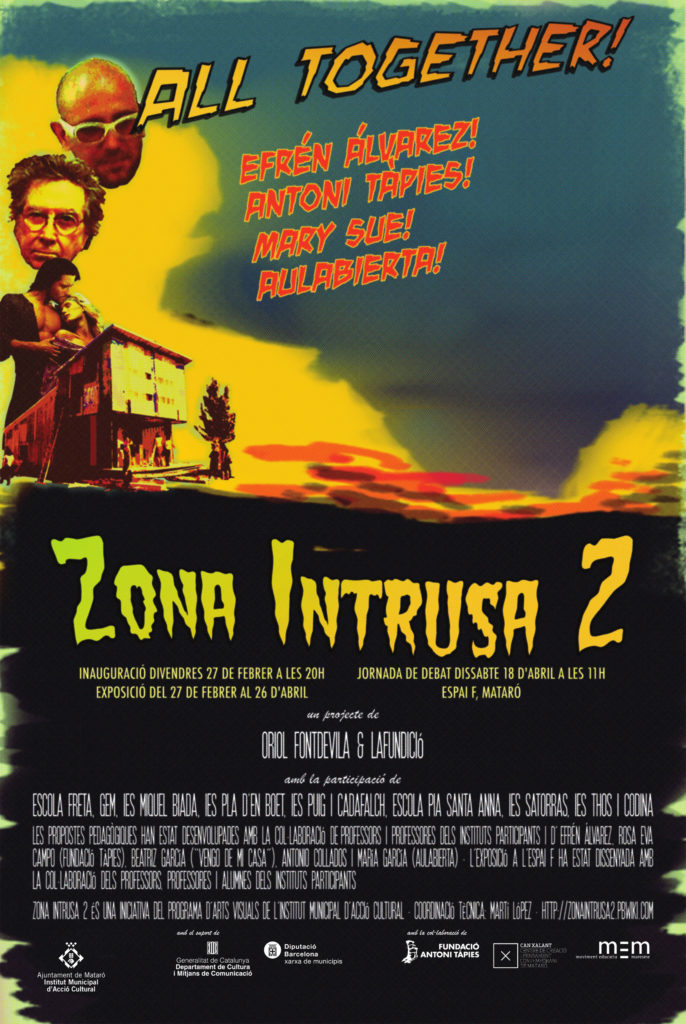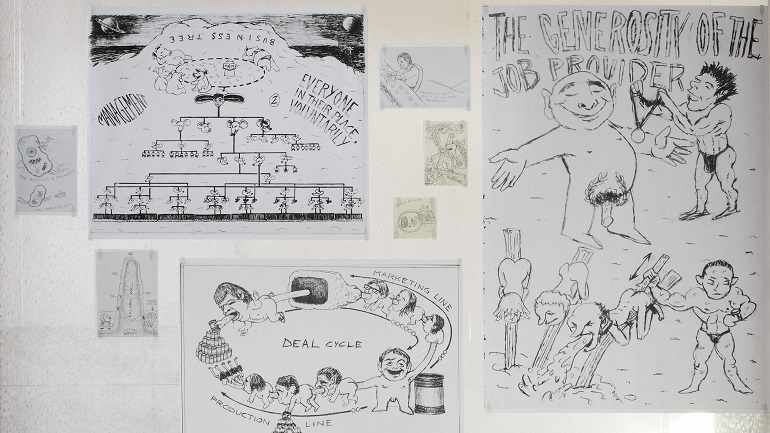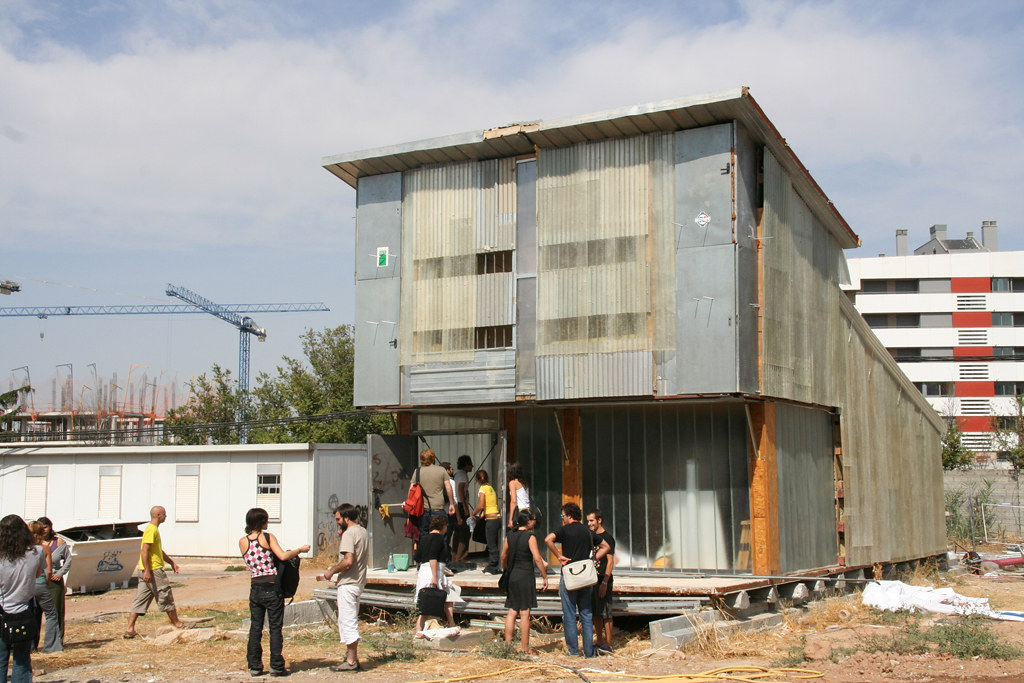


The first edition of Intruder Zone took place in 2007 as an initiative of the Municipal Culture Board of the Mataró City Council (currently IMAC – Municipal Institute of Cultural Action), which wanted to bring contemporary art closer to the secondary education institutes of the city by installing a temporary architectural element containing an exhibition in the courtyards of the same institutes, while at the same time proposing a series of related pedagogical activities to the students. That first edition was curated by Oriol Fontdevila, an independent art critic and curator.
In Intruder Zone 2, Oriol Fontdevila teamed up with LaFundició to design and carry out the curatorial/educational project. It must be said that this team was intentionally transdisciplinary, and an attempt was made to completely erase the separation between the tasks related to curating and those related to pedagogy. Our intention when approaching the project was precisely to critically review this approach of contemporary art to the educational context and formulate a series of questions for collective debate, especially with the students themselves:
Who is this approach useful to? What is it for? What consequences does it have for the artistic sphere? And for the educational sphere?
Likewise, one of our concerns in the design of the project was to ensure, as far as possible, that Intruder Zone 2 was a collective process in which the teachers of the institutes and the participating artists and cultural producers had tools and contexts with and in which to contribute their knowledge; This is why Intruder Zone 2 incorporated a Workshop with the participation of teachers and artists/cultural producers, a wiki site (which was at the same time a tool for work, communication and dissemination of the project) and a second workshop to plan the final exhibition in the Espai F of Mataró that collected the process and the experience as a whole.
We wanted to understand Intruder Zone 2 as a device that raised a series of questions for collective debate, including the students themselves who finally participated in the experience, as well as the negotiation process sustained with the PMCAM on the initial proposal. We must insist that we understand the project as a collective process and not as a ‘service’ offered by the administration to educational centers, for the execution of which a ‘provider’ would have been hired. At the same time, we want to avoid an ‘illustrative’ approach, according to which we, as experts, would approach the institutes, teachers and students in possession of ‘valid’ knowledge that must be ‘learned’.
The main objective of Intruder Zone 2 is to analyze the mechanisms of cultural production so that students can acquire tools not only to make a more complex reading of the works exhibited, but also to establish a map of the processes, structures and contexts that intervene in the evaluation of cultural productions, so that they are able to position themselves critically. What cultural productions are valued? Why? Who gives them value? How is it done? Which of these productions are considered to be part of or excluded from the official curriculum? And again, why? Who decides? What role do students play in this decision?
The main objective of Intruder Zone 2 is to analyze the mechanisms of cultural production so that students can acquire tools not only to make a more complex reading of the works exhibited, but also to establish a map of the processes, structures and contexts that intervene in the evaluation of cultural productions, so that they are able to position themselves critically.
What cultural productions are valued? Why? Who gives them value? How is it done? Which of these productions are considered to be part of or excluded from the official curriculum? And again, why? Who decides? What role do students play in this decision?
The authors/productions were these:

The work of Antoni Tàpies has become part of the collective imagination, of what is understood as ‘contemporary art’ and at the same time is perceived as a figure of authority, that is, even if the recipients of his work are able or not to read it in the terms of ‘artistic criticism’ they assume it as valuable and significant insofar as it is part of the institutional field of art: the museum, history books, the curriculum… The figure of Antoni Tàpies is in a paradoxical situation: while on the one hand, and in line with the modern tradition, he claims the work of art as an autonomous space of subjective freedom, it is supported and surrounded by a gigantic institutional apparatus conditioned by social, economic and political tensions. The work selected for the exhibition, Novel·la, an artist’s book made together with Joan Brossa, focuses precisely on the contrast between the bureaucratic apparatus that conditions and structures the life of an individual (represented by documents such as their birth certificate, family book, contracts, etc.) and the free exercise of pictorial expressiveness on the pages of the book.
More information at www.fundaciotapies.org

Drawing from the series «Later 2006 pack». Record of the classes of Ana Maria Guasch, courses: «South America», «Political Conflicts» and «Art History». Efrén Álvarez’s work develops in the context and circuits of emerging art and under its conditions: precariousness, flexibility, competitiveness… His ‘professional career’ is at a point where his entry into the circuit of commercial galleries, art centers and finally the museum institution can be decided. At the same time, the work selected for the Intruder Zone 2 exhibition (the drawings from the Classroom Collection) addresses and puts into crisis precisely a situation of re-production of knowledge: during his attendance at aesthetics and criticism classes at the Faculty of Fine Arts, he made detailed diagrams of the teachers’ explanations. For Efrén Álvarez his drawings have a purely utilitarian purpose: to represent complex systems in the most accurate way possible. Thus, the representation system that Efrén Álvarez explores in his work, based on diagrams and schemes, can be useful in turn to trace a cartography of the complex systems that we want to address in Intruder Zone 2.

Aulabierta is a project of the AAAbierta Association, formed by students of Fine Arts and Architecture of the University of Granada. The project arises from the need of the students to enable a meeting point and a self-managed training tool that would compensate for the shortcomings of the official curriculum, understanding at the same time that the students must play a primary role in the construction of knowledge that is produced within the university institution and that this role must have a useful academic recognition for the students. Aulabierta (the project) is articulated from a self-constructed physical space: Aulabierta (the building). The architectural space is also understood as a space crossed by power relations, and self-construction constitutes one more strategy to achieve a certain degree of autonomy. Aulabierta is therefore a constantly renegotiated project, which highlights the struggle between the educational institution and the students themselves on the way in which knowledge is produced, re-produced and distributed. Aulabierta has had the collaboration of the architect Santiago Cirugeda, which, in part, has allowed the project to be introduced into the art circuits. This fact, in turn and to some extent, has legitimized the project in the eyes of the university institution, so that art and its context constitute for Aulabierta a strategic tool for visibility and legitimization.
Fanfictions constitute the contemporary version of a very old phenomenon: the reworking of a canonical story by its recipients, in such a way that the story fits their desires and their will to represent. In this way, fanfictions are stories whose authors, generally young people and adolescents, take a given fictional universe (Star Trek, Harry Potter, Buffy the Vampire Slayer…) to introduce new characters, situations and plot lines. When the author of a fanfiction introduces a hyperbolically idealized female character who monopolizes the narrated action, she is known, in the jargon of fanfictions as a «Mary Sue». «Mary Sue» is a pejorative expression in the world of fanfictions insofar as it is considered an extreme form of narcissism and, above all, a destruction of the original ‘canon’. On the other hand, we can also understand Mary Sue as a figure of subaltern criticism and empowerment, insofar as she is contesting the hegemonic representations that the audiovisual media and popular culture offer of adolescents. Fanfictions are produced completely amateur, although this point does not exempt their authors from complying with copyright legislation insofar as they use characters and fictional universes that are not their ‘property’. In this way, a legal (and cultural) debate opens up around the question of whether fanfictions constitute a ‘fair use’ of proprietary material as a commentary or critical essay on the original content. Fanfictions have generated, outside the circuits of ‘official’ culture and cultural industries, a very complex culture of their own, with very specialized codes and jargon. The Internet is the distribution channel of fanfictions and has not only allowed its distribution but has contributed to the generation of this particular culture through forums such as www.fanfiction.net. It is paradoxical that some ‘canonical’ authors such as J.K. Rowlan authorize the creation of fanfictions, as they understand them as a ‘publicity’ medium for their own creations.
More information at www.fanfiction.net
[Before going to the educational center]
a) WORKSHOP FOR DEBATE AND ACTIVITY DESIGN
July 2008
Location: Escola d’Estiu del Maresme
Duration: 10 hours (2 days)
Participants: Teachers, artists and cultural producers
Objective: To design the activities that will be carried out in the educational centers in relation to the itinerant exhibition of the Intruder Zone 2 project.

[Once in the center]
a) ITINERANT EXHIBITION
October to December 2008
One week stay in each educational center. The exhibition was held inside a mobile container that was installed in the courtyard of the centers.
Objective: To show 4 artistic projects that can establish a direct communication with the students and that present different ways of producing culture in the current moment. The projects serve to initiate the debate and the activities that are developed simultaneously in the classrooms.
b) ACTIVITIES IN THE CLASSROOMS
October to December 2008
5 activities to be developed, around the artistic projects of the exhibition.
Educational proposal based on the result of the joint workshop of teachers and artists. Classroom activities by the team of educators of Intruder Zone 2.
Activities open to the contributions of the teacher.
[After being in the center]
c) WORKSHOP FOR THE ASSESSMENT AND DESIGN OF THE FINAL PRESENTATION
Between December 2008 and January 2009
Working sessions with teachers, artists and cultural producers.
d) EXHIBITION IN THE ESPAI F
February 2009
Exhibition for the public presentation of the project.